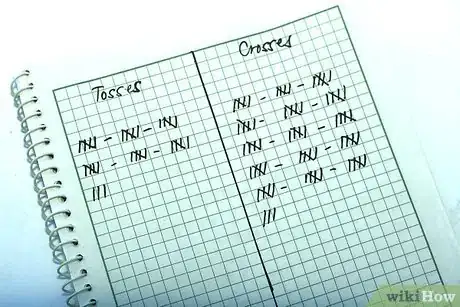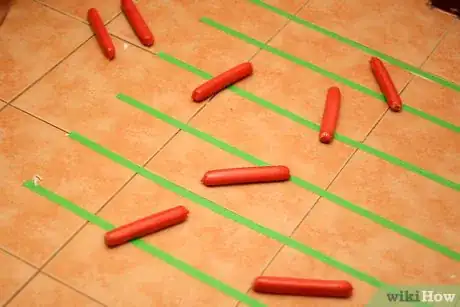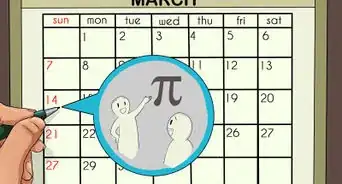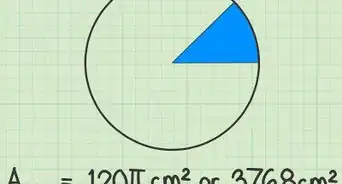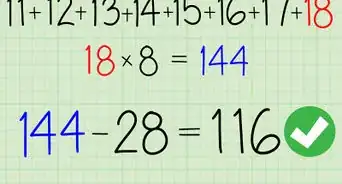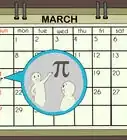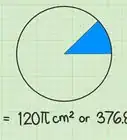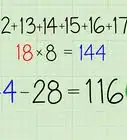wikiHow is a “wiki,” similar to Wikipedia, which means that many of our articles are co-written by multiple authors. To create this article, 92 people, some anonymous, worked to edit and improve it over time.
This article has been viewed 963,076 times.
Learn more...
Throwing a pie in someone's face is good. Throwing food to discover pi is better. Believe it or not, of all the countless ways to approximate the most prolific irrational number in the universe, there are none quite as interesting or as surprisingly satisfying as throwing perfectly good food around your kitchen. In fewer steps than it takes to circumscribe your house in a circle of baguettes, you, too, can easily add a slice of pi into your dinner menu tonight. The best part is... it really works!
Steps
Calculating Pi by Throwing Frozen Hot Dogs
-
1Select a food item to throw. There are a couple of qualifications. First, it must be long, thin, hard, and straight, like a frozen hot dog, for example. Second, it must be a reasonably stiff item. Third, it should be somewhere between 15 and 20 cm (6-8 inches) long; the experiment can be performed otherwise, but read on, and you will see why this size is optimal. There are lots of other items that fit these criteria including Otter Pops, celery, and churros. (If you simply can't come to grips with throwing perfectly good food, see the Tips section for some additional ideas.)[1]
-
2Select the spot from which to throw your mathematical cuisine. You will probably need about 180-300 cm (6-10 feet) in front of you, as you will be throwing straight ahead.Advertisement
-
3Clear the area. The place at which you are throwing should be devoid of objects that your food item could possibly run in to. So, if you are throwing in your kitchen, consider moving the table into another room or at least throwing in such a way that your food won't hit the table during its flight.
-
4Measure the length of your projectile. A tape measure should do the trick. Be as accurate as you can, even down to the millimeter, for best results. Since length is a factor, it’s best to choose food items that are all the same size. If you’ve chosen something that isn’t naturally uniform, such as celery sticks, cut them evenly beforehand.
-
5Lay down masking tape in parallel strips across the floor as far apart as your projectile is long. The strips should be perpendicular to the direction you will be throwing. If your item is 15-45 cm (6-18 inches) long, lay down about 6-10 strips; lay down fewer if longer and more if shorter.[2]
-
6On a piece of paper, make a column for “Tosses” and another column for "Crosses." The "Tosses" column is where you’ll keep track of how many times you throw your food item. The "Crosses" column is where you’ll keep track of how many times your item lands across one of the lines. (Note that landing is not the same thing as bouncing.)[3]
-
7Get into position and THROW YOUR FOOD! Throw just one item at a time. Once it is at rest, observe whether or not it is crossing one of the lines. If it is, put a tick under "Crosses" and a tick under "Tosses." If it isn't, just put a tick under "Tosses." When you’ve run out of hot dogs, pick them up and re-use them, making sure to throw from the same position. Repeat this as many times as you like. You should start seeing some interesting results by around 100 to 200 throws. (This doesn't take as long as it sounds.)[4]
-
8When you’re done, divide the number of crosses by 2 and divide the number of tosses by that. For example, if you threw 300 times, and it crossed 191 times, you would calculate 300/(191/2). And, to your amazement, you will now have an approximation for pi![5]
Calculation Chart
Community Q&A
-
QuestionCan I do this during my exam if I don't have a calculator?
 Community AnswerYou can try, but your teacher might not be too happy about it!
Community AnswerYou can try, but your teacher might not be too happy about it! -
QuestionWhy would I do this instead of using a calculator?
 Community AnswerBecause it's way more fun, and your teachers always said that you wouldn't always have a calculator on you.
Community AnswerBecause it's way more fun, and your teachers always said that you wouldn't always have a calculator on you. -
QuestionWhy would someone do this?
 MysticalExperimentationCommunity AnswerWhy not? Bragging rights if nothing else. How many people can say they did fancy math with frozen hot dogs, and had fun with it too?
MysticalExperimentationCommunity AnswerWhy not? Bragging rights if nothing else. How many people can say they did fancy math with frozen hot dogs, and had fun with it too?
Warnings
- If you have a pet (e.g. dog or cat), they may feel inclined to eat the hot dogs, and thus ruin your experiment. Try putting your critters outside (or in another room if they have to stay inside) for this experiment.⧼thumbs_response⧽
- Hitting someone in the eye with a hot dog, even if very funny, is generally not a good idea -- especially if it is frozen.⧼thumbs_response⧽
- Resist the temptation to use bananas. Not only are they not really straight, but they really won't last more than 50 throws before creating a big mess. Really.⧼thumbs_response⧽
- Remember that this is an experiment, so the idea is not to try to get the food to land on one of the lines. Just throw it randomly towards the lines. It should still land amongst them, but don't jinx the experiment by encouraging your dinner to land onto the tape.⧼thumbs_response⧽
- Though there is no food that is more fun to throw than hot dogs, the math buff will note that greater accuracy will be found the thinner the lines of tape and the thinner the food. Try uncooked spaghetti sticks, for example, for greater accuracy.⧼thumbs_response⧽
Things You'll Need
- Pen and Paper
- Masking Tape
- Calculator
- Long, thin, straight, stiff food items, preferably a pack of frozen hot dogs
References
- ↑ https://www.howtosmile.org/resource/smile-000-000-004-972
- ↑ https://www.mathsisfun.com/activity/buffons-needle.html
- ↑ https://www.youtube.com/watch?v=szUH1rzwbAw
- ↑ https://www.mathsisfun.com/activity/buffons-needle.html
- ↑ https://www.exploratorium.edu/snacks/pi-toss
- This article is a humorous rendition of a real experiment called the Buffon Needle Problem
About This Article
If you’re looking for a fun science experiment, you can calculate pi by throwing frozen hot dogs. First, measure the precise length of the hot dogs. Choose a spot where you have 180-300 cm of empty space and lay down strips of masking tape in parallel lines spaced exactly as far as the hot dogs are long. Throw the hot dogs, keeping track of how many times you throw and how often a hot dog lands on one of the lines. When you’re done, divide the number of crosses by 2, then divide the number of tosses by that result. The result will be an approximation of pi! Keep reading to learn about other objects you can use, like celery sticks or popsicles!





